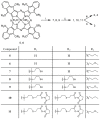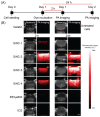Optimizing Axial and Peripheral Substitutions in Si-Centered Naphthalocyanine Dyes for Enhancing Aqueous Solubility and Photoacoustic Signal Intensity
- PMID: 36768560
- PMCID: PMC9916426
- DOI: 10.3390/ijms24032241
Optimizing Axial and Peripheral Substitutions in Si-Centered Naphthalocyanine Dyes for Enhancing Aqueous Solubility and Photoacoustic Signal Intensity
Abstract
Photoacoustic imaging using external contrast agents is emerging as a powerful modality for real-time molecular imaging of deep-seated tumors. There are several chromophores, such as indocyanine green and IRDye800, that can potentially be used for photoacoustic imaging; however, their use is limited due to several drawbacks, particularly photostability. There is, therefore, an urgent need to design agents to enhance contrast in photoacoustic imaging. Naphthalocyanine dyes have been demonstrated for their use as photoacoustic contrast agents; however, their low solubility in aqueous solvents and high aggregation propensity limit their application. In this study, we report the synthesis and characterization of silicon-centered naphthalocyanine dyes with high aqueous solubility and near infra-red (NIR) absorption in the range of 850-920 nm which make them ideal candidates for photoacoustic imaging. A series of Silicon-centered naphthalocyanine dyes were developed with varying axial and peripheral substitutions, all in an attempt to enhance their aqueous solubility and improve photophysical properties. We demonstrate that axial incorporation of charged ammonium mesylate group enhances water solubility. Moreover, the incorporation of peripheral 2-methoxyethoxy groups at the α-position modulates the electronic properties by altering the π-electron delocalization and enhancing photoacoustic signal amplitude. In addition, all the dyes were synthesized to incorporate an N-hydroxysuccinimidyl group to enable further bioconjugation. In summary, we report the synthesis of water-soluble silicon-centered naphthalocyanine dyes with a high photoacoustic signal amplitude that can potentially be used as contrast agents for molecular photoacoustic imaging.
Keywords: image-guided therapy; naphthalocyanine dyes; photoacoustic imaging; silicon-centered naphthalocyanine dyes; water-soluble naphthalocyanines.
Conflict of interest statement
Scott Selfridge and Robert Pawle are full time employees of Akita Innovations, LLC, a provider of custom designed bioimaging dyes. All other authors declare no competing financial interest.
Figures








Similar articles
-
Highly-Soluble Cyanine J-aggregates Entrapped by Liposomes for In Vivo Optical Imaging around 930 nm.Theranostics. 2019 Jan 1;9(2):381-390. doi: 10.7150/thno.28376. eCollection 2019. Theranostics. 2019. PMID: 30809281 Free PMC article.
-
Functional computer-to-plate near-infrared absorbers as highly efficient photoacoustic dyes.Acta Biomater. 2016 Oct 1;43:262-268. doi: 10.1016/j.actbio.2016.07.026. Epub 2016 Jul 16. Acta Biomater. 2016. PMID: 27431878
-
Near-Infrared Heptamethine Cyanine Dyes for Nanoparticle-Based Photoacoustic Imaging and Photothermal Therapy.J Med Chem. 2021 Jun 24;64(12):8798-8805. doi: 10.1021/acs.jmedchem.1c00771. Epub 2021 Jun 3. J Med Chem. 2021. PMID: 34081463 Free PMC article.
-
Activatable Small Molecule Probes for Photoacoustic Imaging: Dyes and Applications.Curr Med Chem. 2022;29(39):6008-6029. doi: 10.2174/0929867329666220208093735. Curr Med Chem. 2022. PMID: 35135445 Review.
-
New contrast agents for photoacoustic imaging and theranostics: Recent 5-year overview on phthalocyanine/naphthalocyanine-based nanoparticles.APL Bioeng. 2021 Jul 30;5(3):031510. doi: 10.1063/5.0047660. eCollection 2021 Sep. APL Bioeng. 2021. PMID: 34368604 Free PMC article. Review.
Cited by
-
Temporal dynamics of fluorescence and photoacoustic signals of a Cetuximab-IRDye800 conjugate in EGFR-overexpressing tumors.bioRxiv [Preprint]. 2024 Dec 2:2024.11.26.625469. doi: 10.1101/2024.11.26.625469. bioRxiv. 2024. PMID: 39677759 Free PMC article. Preprint.
-
A Dual Function Antibody Conjugate Enabled Photoimmunotherapy Complements Fluorescence and Photoacoustic Imaging of Head and Neck Cancer Spheroids.bioRxiv [Preprint]. 2023 Feb 2:2023.01.30.526194. doi: 10.1101/2023.01.30.526194. bioRxiv. 2023. Update in: Bioconjug Chem. 2024 Jan 17;35(1):51-63. doi: 10.1021/acs.bioconjchem.3c00406. PMID: 36778405 Free PMC article. Updated. Preprint.
-
Reduction of photobleaching effects in photoacoustic imaging using noise agnostic, platform-flexible deep-learning methods.J Biomed Opt. 2025 Dec;30(Suppl 3):S34102. doi: 10.1117/1.JBO.30.S3.S34102. Epub 2025 May 28. J Biomed Opt. 2025. PMID: 40443946 Free PMC article.
-
Dual Emissive Zn(II) Naphthalocyanines: Synthesis, Structural and Photophysical Characterization with Theory-Supported Insights towards Soluble Coordination Compounds with Visible and Near-Infrared Emission.Int J Mol Sci. 2024 Feb 23;25(5):2605. doi: 10.3390/ijms25052605. Int J Mol Sci. 2024. PMID: 38473852 Free PMC article.
-
Dual-Function Antibody Conjugate-Enabled Photoimmunotherapy Complements Fluorescence and Photoacoustic Imaging of Head and Neck Cancer Spheroids.Bioconjug Chem. 2024 Jan 17;35(1):51-63. doi: 10.1021/acs.bioconjchem.3c00406. Epub 2023 Dec 21. Bioconjug Chem. 2024. PMID: 38128912 Free PMC article.
References
MeSH terms
Substances
Grants and funding
LinkOut - more resources
Full Text Sources
Research Materials
Miscellaneous

